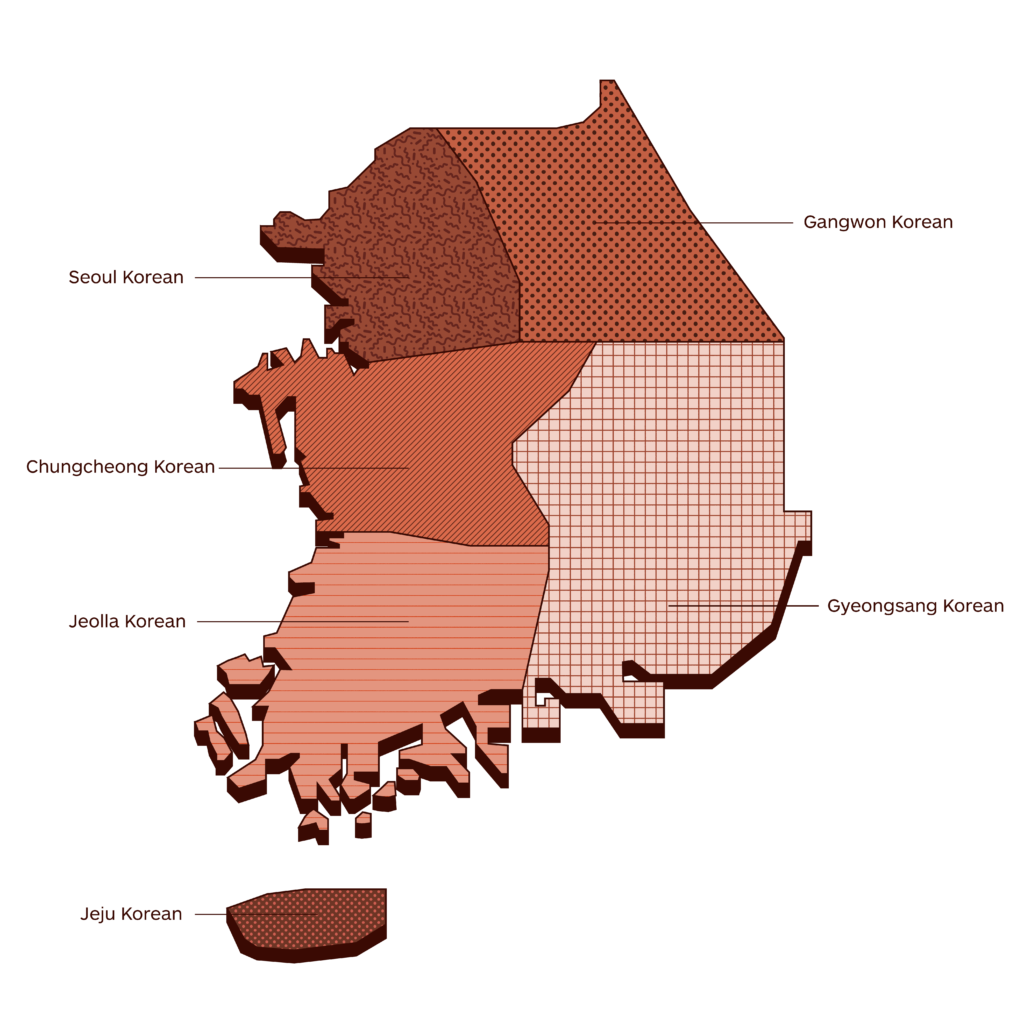Asia
To which language should you translate to localize in South Korea?
What we know from our community
“Korean is the one and only language spoken on the Korean peninsula. Although the dialects and vocabularies of the North and the South differ, both countries share the same language and people from the two sides can communicate without any problem. Within South Korea, there are regional dialects but the dialect spoken in Seoul and the surrounding Gyeonggi Province is considered the “Standard Language.”
One important thing to note when you consider localizing your content into Korean is that the language is significantly different from English, both in terms of syntax (word order) and rhetoric. A standard Korean sentence has the word order of “subject – object – verb or predicate”; while the order of subject and object is flexible, the verb/predicate must always come at the end of a sentence in Korean. The Korean language is sensitive in politeness and there are 4-7 degrees of politeness expressed through the language. Therefore it is very important to set the right level of politeness and tone in the localized content. “Informal” level of politeness is reserved for close friends or people lower in the social hierarchy in relation to the speaker; therefore, if the content is for the general public, it should always be written in a formal and polite way, even if the tone is casual and friendly“.
LANGUAGE INSIGHT
Official language
Korean (99.9%)
Actual languages
Korean (99.9%), Chinese (0.1%)
What the top 150 best localized websites in the world do in South Korea
(Top 150 websites listed in the Global by Design ranking – published annually by Byte Level Research, this report provides a list of globally localized websites, showcasing best practices and emerging trends in their globalization)
- 115/150 localize by translating into Korean
- 4/150 localizes by translating into both Korean and Simplified Chinese
- 1/150 localizes by translating into both Korean and Korean Sign Language
- 1/150 localizes by translating into Korean, Simplified Chinese and French
- 1/150 localizes by translating into Korean, Simplified Chinese, Traditional Chinese, Japanese, German, Spanish, Italian, Portuguese, Russian and French
- 1/150 localizes by translating into both Japanese and French
- 1/150 localizes by translating into Simplified Chinese, Traditional Chinese, Japanese, German, Spanish, Italian, Portuguese, Russian, French, Korean Sign Language, Arabic, Hungarian, Bahasa Indonesia, Polish, Romanian, Thai, Turkish and Ukrainian
-
3M
-
ABB
-
Accenture
-
Adidas
-
Adobe
-
Airbnb
-
Aldi
-
Amazon
-
American Airlines
-
American Express
-
Apple
-
Audi
-
Autodesk
-
Avis
-
Bayer
-
BMW
-
Booking.com
-
Bosch
-
British Airways
-
Bumble
-
Burberry
-
BYD
-
Canon
-
Capgemini
-
Cartier
-
Caterpillar
-
Chevrolet
-
Cisco Systems
-
Citibank
-
Coca-Cola
-
Costco
-
Dell
-
Deloitte
-
Delta
-
DHL
-
Disney+
-
Dyson
-
eBay
-
Eli Lilly
-
Emirates
-
Ernst & Young
-
Facebook
-
FedEx
-
Ford
-
Four Seasons
-
Fujifilm
-
GE
-
Gillette
-
GoDaddy
-
Google
-
Gucci
-
Haier
-
Heineken
-
Hermès
-
Hertz
-
Hilton
-
Hisense
-
Hitachi
-
Honda
-
Hotels.com
-
HP
-
HP Enterprise
-
HSBC
-
Huawei
-
Hyatt
-
Hyundai
-
IBM
-
IKEA
-
Intel
-
InterContinental Hotels
-
J&J
-
Jack Daniel's
-
Jehovah’s Witnesses
-
John Deere
-
Kellogg's
-
Kia
-
KPMG
-
L'Oréal
-
Land Rover
-
LEGO
-
Lenovo
-
Lexus
-
LG
-
Louis Vuitton
-
Lululemon
-
LUSH
-
Marriott
-
MasterCard
-
McDonald's
-
Mercedes-Benz
-
Merck
-
Microsoft
-
Mitsubishi Electric
-
Nestlé
-
Netflix
-
Nike
-
Nikon
-
Nintendo
-
Nio
-
Nissan
-
NIVEA
-
Oracle
-
Pampers
-
Panasonic
-
PayPal
-
Pepsi
-
Pfizer
-
Philips
-
Pitney Bowes
-
Porsche
-
Procter & Gamble
-
PWC
-
Revolut
-
Rolex
-
Royal Caribbean
-
Salesforce
-
Samsung
-
Sanofi
-
SAP
-
Sephora
-
Shopify
-
Siemens
-
Sony
-
Spotify
-
Starbucks
-
Steelcase
-
Stripe
-
Subaru
-
Tesla
-
The Church of Jesus Christ of Latter-day Saints
-
Tiffany
-
Tinder
-
Toshiba
-
Toyota
-
TripAdvisor
-
Uber
-
United Airlines
-
UPS
-
Visa
-
Volkswagen
-
Volvo Cars
-
Vrbo
-
Walmart
-
Western Union
-
Wikipedia
-
Wise
-
WordPress
-
Workday
-
Xerox
-
Xiaomi (Mi)
-
Zara
-
Zoom
If you need others information, below you can find a selection of economic/social/cultural data
Overview
Language
Official language
Korean (Pyojuneo),
Korean Sign Language.
T-index
1.7%
T-Index ranks countries according to their potential for online sales.
Other languages
English, Japanese, Mandarin.
English
Moderate proficiency (EF) – 49 of 113 countries/regions in the world- 5/23 position in Asia.
Demography
Capital: Seoul
Currency: South Korean Won
Population: 51.77 mln
Population density: 523.2/km2
Economy
GDP: 1.67 Trillion USD (2022)
GDP per capita: 32,422.6 USD (2022)
Exports: $705 billion (2022)
Statistics
Internet users: 97.2% penetration, 50.30 million
Unemployment rate: 2.7% (2023)
Urbanisation: 81.5% (2024)
Literacy: 98.8% (2024)
Conventions
Numbering system
Arabic numbering system with the comma as decimal separator
Date format: dd – mm – yyyy
Time: 24h time system
Country code: 0055
Language data sources: Worldatlas/Britannica//EF/Wikipedia; Demography data sources: IMF/Worldometers; Conventions data source: Wikipedia; Economy data sources: WTO/OEC/CIA/Esomar/Datareportal; Statistics data sources: Datareportal/WorldBank/UN/UNESCO/CEIC/IMF/Culturalatlas/Commisceoglobal
Facts and data
Economy
Imports
$666 billion (2022). Crude Petroleum ($89.1B), Integrated Circuits ($56.4B), Petroleum Gas ($46.9B), Coal Briquettes ($26.8B), and Refined Petroleum ($26.1B), importing mostly from China ($150B), United States ($73.6B), Japan ($50.8B), Australia ($41B), and Saudi Arabia ($36B).
Financial inclusion factors (over 15 years of age)
• 94.9% have an account with a financial institution
• 63.7% have a credit card
• 76% make online purchases
Ease of doing business
It is very easy to conduct business (rated 84 out of 100) 3rd out of 34 Asia Pacific countries 5th worldwide out of 190 countries (2020, World Bank).
Exports
$705 billion (2022). Integrated Circuits ($121B), Refined Petroleum ($61.4B), Cars ($52.1B), Broadcasting Equipment ($24.2B), and Motor vehicles; parts and accessories (8701 to 8705) ($20B), exporting mostly to China ($150B), United States ($112B), Vietnam ($60.7B), Japan($30.5B), and Hong Kong ($28.9B).
Main local online stores
Coupang, 11th Street, Interpark Global, G-market, Kurly Market.
Economic freedom
‘Mostly free’ (73.1 out of 100) 5th out of 39 countries in Asia Pacific, 14th worldwide out of 186 countries (2024, Heritage Foundation and Wall Street Journal).
Global Innovation Index
Ranked 2nd out of South East Asian, East
Asian, and Oceanian countries, 10th out of 132 worldwide.
The Global Innovation Index captures the innovation
ecosystem performance of 132 economies and tracks the most recent global innovation trends.
Economy data sources: WTO/OEC/CIA/Esomar/Datareportal

The Korean Waves
What's Imminent In South Korea
Each month, we spotlight a country with its own unique characteristics. Using analytical lens, we explore What’s Imminent in the linguistic, cultural, and economic tapestry to unveil its true character. Join us in this insightful exploration to understand the distinctive dynamics of each region.
Read it now!Service Imports
Service Exports
Source: OEC
Trade balance of goods from 2012 to 2022
Source: Statista
Historical Data Trade Imports
The following section uses historical trade data imports from partners of South Korea.
Historical Data Trade Exports
The following section uses historical trade data exports from partners of South Korea.
Source: OEC
The Top Export Opportunities for South Korea by Relatedness
Relatedness measures the distance between a country's current exports and each product by showing only products that South Korea is not specialized in.
South Korea's Most Complex Exports
The Product Complexity Index (PCI) measures the knowledge intensity of a product by considering the knowledge intensity of its exporters.
Source: OEC
South Korea's Most Specialized Products
Specialization is measured using Revealed Comparative Advantage (RCA), an index that takes the ratio between South Korea observed and expected exports in each product.
Source: OEC
Perception of products made in selected countries in 2017
Source: Statista
Which attributes do you associate with products made in South Korea?
Source: Statista
Market Growth Imports
This score represents the likelihood that the given country will start importing that product in the next few years. It forecasts the opening of a new specific market.
Market Growth Exports
This score represents the likelihood that the given country will start exporting that product in the next few years. It forecasts the opening of a new specific market.
Source: OEC
Foreign direct investment, net inflows (% of GDP)
Source: WorldBank
Most commonly used mobile payment providers in South Korea in 2019
Source: Opensurvey

T-index
Reach most of the online purchasing power
T-Index ranks countries according to their potential for online sales. It estimates the market share of each country in relation to global e-commerce.
Try it nowMedia
Media language Korean, English
Information channels
TV is influential and the major terrestrial networks, including market leaders KBS and MBC, command the biggest audiences. Most South Koreans subscribe to digital cable, satellite or Internet Protocol TV (IPTV). South Korean TV soaps are popular across the region, including in China. They are part of the Korean Wave – the export of South Korean popular culture across Asia. Newspaper readership is high and there are more than 100 national and local dailies. The press is often critical of the government. Many newspapers are controlled by industrial conglomerates. A defamation law that provides for prison sentences prompts self-censorship, says Reporters Without Borders (RSF). A security law banning content deemed favourable to North Korea and is one of the main grounds for online censorship, the group says. South Korea is a trailblazer for high-speed and wireless internet. More than 88% of internet users are connected to a messenger service. Local platform KakaoTalk is hugely popular. Online gaming is a national passion.
The press
Chosun Ilbo – English-language pages
Dong-a Ilbo – English-language pages
The Korea Times – English-language
The Korea Herald – English-language
Hangyore Sinmun – English-language pages
JoongAng Ilbo – English-language pages
Hankook Ilbo – daily
Korea Economic – Daily
Munhwa Ilbo – daily
Segye Ilbo – daily
Television
Korea Broadcasting System (KBS) – public
Munhwa Broadcasting Corporation (MBC) – public
Seoul Broadcasting System (SBS) – private
Education Broadcasting System (EBS) – public Jeonju Television Corporation (JTV) – private
Radio
Korea Broadcasting System (KBS) – public
KBS World Radio – external, multilingualRadio Munhwa Broadcasting Corporation – public, operates MBC Radio and music-based MBC FM
Seoul Broadcasting System – operates SBS-FM
Christian Broadcasting System (CBS)
Buddhist Broadcasting System (BBS)
tbs eFM – Seoul, English-language
News agency
Yonhap News Agency – English-language pages
Media data source: BBC
Internet Data
Internet users
97.2% penetration, 50.30 million (2024).
Share of web traffic by device
60.48% mobile phones, 38.68% computers (laptops and desktops), 0.84% tablet devices.
Median speed of mobile Internet connection
136.40 Mbps
Median speed of fixed Internet connection
123.36 Mbps
Mobile connection as a percentage of total population: 128.3%
Percentage of mobile connections that are broadband (3G-5G): 99.7%
Most popular web search engines
Google (52.33%), Naver (40.48%), Bing (3.76%), Daum (1.6%) CocCoc (0.65%), Yahoo (0.43%).
Most used social media
Facebook (59.13%), YouTube (33.25%), Twitter (4.09%), Instagram (2.3%), Pinterest (0.75%), reddit (0.23%).
Internet data sources: Datareportal/Statcounter
Social statistics
Life expectancy
84 yrs (2021)
Current health expenditure
8.36% of GDP (2020)
Current education expenditure
81.5 (2020)
Average age of the population
45.1 yrs (2024)
CO2 emissions
11 metric tons per capita
World Happiness Index
South Korea ranked 59 out of 146 countries, with a score of 5.935.
Corruption perceptions Index
South Korea scored 63 out of 100, ranked 31 out 180 countries worldwide (2023).
Glass Ceiling Index
24.8 out 100, ranked 29th out of 29 countries.
The glass-ceiling index measures the environment for working women combining data on higher education, labor-force participation, pay, child-care costs, maternity and paternity rights, business-school applications, and representation in senior jobs.
Social statistics sources: WorldBank/UN/UNESCO/CEIC/IMF
The Data Factbook is a work in progress project. Our community is helping us to fill it up always with new and updated data. Your contribution is precious. If you want to help us, please write your advices at imminent@translated.com
Country Curiosities
In Korea, the number four is considered unlucky because its pronunciation, “sa,” is similar to the word for death. This superstition is so strong that many buildings skip the number four in their floor numbering, replacing it with “F” for “floor.” This cultural aversion to the number four reflects a deep-rooted fear of death, common in various East Asian cultures, that influences approaches to architecture and daily life.
Additionally…
- A Korean person born on the same day as you is considered one year older because the gestation period is counted. A newborn is considered one year old.
- It is customary to give toilet paper, soap, and cleaning products as housewarming gifts, as this is believed to bring good luck. This tradition dates from the period after the Korean War, when such items were considered luxurious.
- Makeup for men is popular thanks to the influence of K-pop. It is common to see male idols wearing lipstick, mascara, or foundation, reflecting the importance of appearance in Korean society.
- South Korea’s medical sector is experiencing a plastic surgery boom and employs almost 2,600 specialists. Both young men and women often undergo cosmetic procedures, making the country a hotspot for medical tourism.
- Instead of WhatsApp, South Koreans use KakaoTalk for messaging, voice messages, video calls, and sending stickers.
- Rather than the wooden or plastic chopsticks used in China and Japan, Koreans use metal chopsticks, historically made of silver to detect poison.
- South Korea’s public transport is highly efficient. Metro stations play different music for each line, have arrows indicating where to stand, and use the T-money card, a prepaid card for transport and shopping.
Languages research
Korean dialects

Legend
-
Seoul Korean
-
Gangwon Korean
-
Chungcheong Korean
-
Jeolla Korean
-
Gyeongsang Korean
-
Jeju Korean
The geographical distribution of languages that you will find in the maps published in this section is a work in progress. Our community is helping us to fill it up with always new and updated data. Your contribution is precious. If you want to help us, please write to imminent.factbook@translated.com
Photo credit: Jet Dela Cruz, Unsplash


